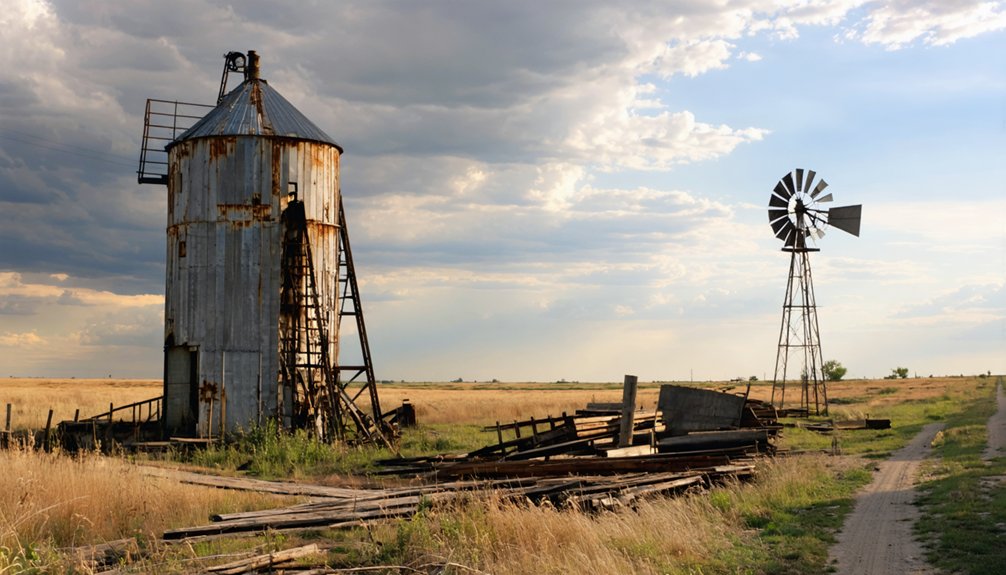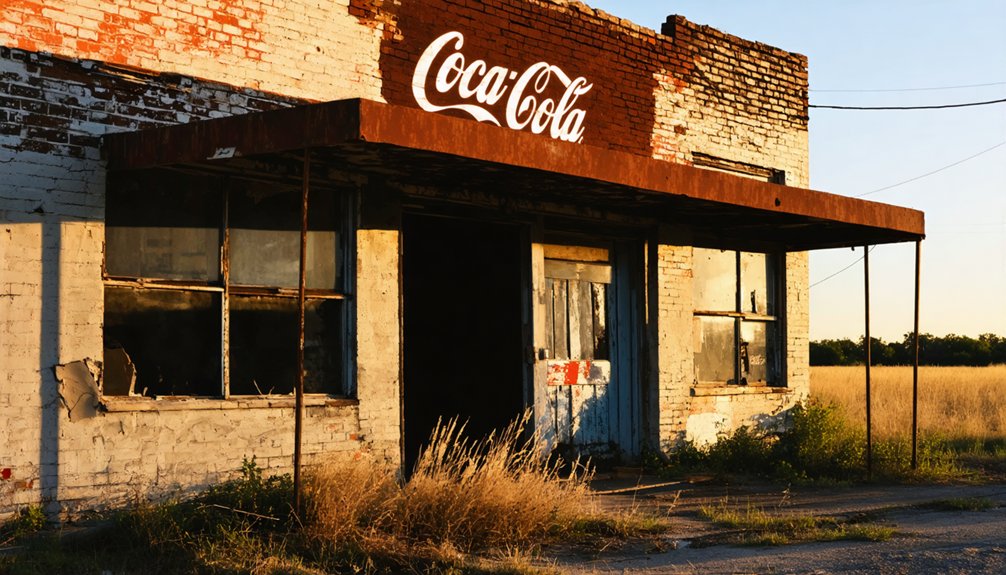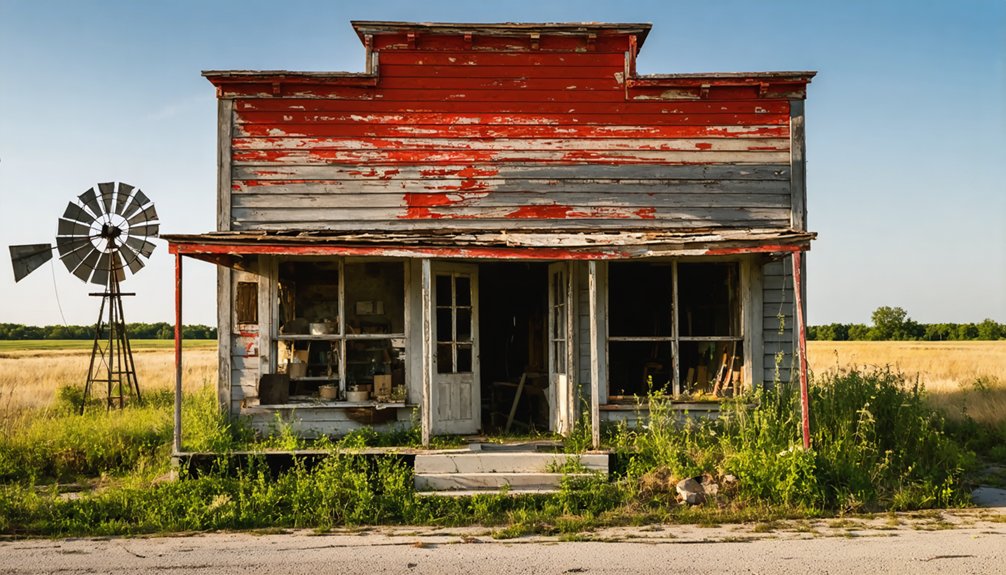You’ll find Huff, Texas along abandoned railroad tracks where a thriving community once stood. Established in 1908 as a switching site for the Wichita Falls and Southern Railway, Huff grew to 250 residents by 1914, complete with a post office, blacksmith shop, and general store. The town’s population dwindled to 50 by mid-century before its complete abandonment in the 1970s. The weathered remnants and silent rail beds hold countless stories of this vanished Texas settlement.
Key Takeaways
- Founded in 1908 as a railroad switching site, Huff was named after railroad attorney Charles C. Huff.
- The town’s infrastructure included a post office, blacksmith shop, general store, and concrete cistern filled by railroad tank cars.
- Population peaked at 250 residents in 1914 before declining to 50 by mid-century, leading to eventual abandonment.
- Essential services closed rapidly, with the post office shutting down by 1913 and most businesses following suit.
- By 1936, only a schoolhouse and scattered dwellings remained, marking Huff’s transformation into a ghost town.
Origins and Early Settlement
While many Texas towns emerged organically from settler communities, Huff’s establishment in 1908 came directly from the Wichita Falls and Southern Railway‘s need for a switching site. Named after railroad attorney Charles C. Huff, the town’s strategic location near Lake Creek, eight miles south of Lakeside City, proved crucial for early residents facing settlement challenges.
You’ll find the town’s early infrastructure centered around a large concrete cistern, filled by railroad tank cars to combat water supply issues. Since the town’s name had multiple meanings, local historians often needed to clarify whether they were referring to the attorney or the settlement itself. The community quickly developed essential services, including a post office that operated from 1909 to 1913, a blacksmith shop, and a general store. The town was ultimately abandoned in 1970s as railroad operations diminished in the region.
Despite being primarily a railroad-focused settlement, the site became a gathering place for local cattle ranchers, contributing to the area’s economic activity.
The Railroad’s Influence
Since its founding in 1908, the Wichita Falls and Southern Railway shaped every aspect of Huff’s development as a railroad switching site. Named after attorney Charles C. Huff, the town’s strategic location alongside the tracks spurred crucial infrastructure growth and community development. Like many population declines in Cherokee County, the town eventually faded away as rail service diminished. Like many railroad towns, locals would gather with excitement to watch train arrivals and departures.
The railroad’s community impact was evident through:
- Essential services that emerged near the tracks, including a post office, blacksmith shop, general store, and school.
- A large concrete cistern that stored water from rail tank cars, providing fresh water to residents.
- Economic opportunities through improved market access for local farming and ranching operations.
- Long-term influence on social life, as seen when ranchers later used the former school as a community center.
Railroad expansion defined Huff’s fate, from its boom during active rail service to its decline following the track’s 1970s abandonment.
Community Growth and Development
Unlike Huff’s railroad-centric origins, the community’s broader development tells a story of gradual expansion and social evolution.
You’ll find that early population numbers hovered around 250 residents by 1914, though this dropped markedly to 50 during the mid-century period between the 1940s and 1990s. This decline mirrors the fate of many rural Texas communities that continue to experience population loss today.
Community demographics reflect the era’s social divides, with separate schools for Black and White students established by 1905.
Segregated education facilities in 1905 mirrored the deep-rooted social divisions that shaped the community’s early development.
Educational disparities were evident in the limited scope of local schooling, as the district only offered elementary education through 1961, despite covering 58 square miles. Similar to towns like Plemons Crossing, which initially thrived around essential services but later faded, Huff’s trajectory followed a common pattern of rural Texas settlements.
You can trace the town’s eventual revival through its business growth – from 36 establishments in 1990 to 192 by 2000, marking a notable shift in local commerce and community vibrancy.
Notable Infrastructure
Looking back at Huff’s infrastructure, you’ll find remnants of the 1928 railroad that shaped the town’s early development, including abandoned tracks and an old water supply system that once served steam locomotives.
Similar to Albert, Texas, only ruins and a cemetery remain of what was once a thriving community.
The town’s most prominent structures include towering grain elevators that dominated local agriculture, alongside a historic church and scattered early 20th-century buildings that reveal the community’s past vibrancy.
Freedom colonies created similar self-sustaining settlements throughout Texas, establishing their own infrastructure and community spaces between 1865 and 1920.
While the original rail lines no longer operate, you can still access Huff through a network of maintained rural roads that connect the remaining inhabited structures to neighboring communities.
Railroad Water Supply System
As Texas railroad towns developed in the early 20th century, Huff’s water infrastructure became intertwined with the Railroad Commission‘s oversight of oil, gas, and pipeline operations.
The town’s water management system faced significant contamination risks from produced water and oilfield activities, requiring careful monitoring and regulation. Due to inconsistent oversight, many incidents went unreported as district offices varied in their spill reporting requirements. The region generated 3.9 billion barrels of produced water annually, straining local infrastructure.
- You’ll find that historic water supply infrastructure included wells, storage tanks, and distribution systems vulnerable to produced water spills.
- The RRC’s jurisdiction extended to both railroad operations and petroleum activities, affecting how water resources were managed.
- Deep well injection served as the primary disposal method for produced water near railroad infrastructure.
- Storage facilities posed ongoing risks of large-volume spills that could impact soil quality and water supplies essential for railroad town operations.
Historic Buildings and Structures
Despite its brief period of importance, Huff’s historic buildings and structures tell the story of a typical early 20th-century Texas railroad town.
You’ll find the schoolhouse remains as the most prominent structure, featuring architectural styles common to rural Texas education buildings of that era. The school served dual purposes as both a learning center and community gathering space through 1936.
Other key structures included a post office (1909-1913), blacksmith shop, and general store that formed the town’s commercial core.
While preservation efforts have maintained some elements of the schoolhouse, most buildings have succumbed to weathering and vandalism.
The large concrete cistern stands as evidence of the railroad’s influence, having stored water essential for steam locomotives and community use.
Transportation Network Features
While Huff’s transportation infrastructure centered primarily on the Wichita Falls and Southern Railway established in 1908, the town’s network extended beyond just rail service.
You’ll find that transportation challenges and rural accessibility shaped the community’s development and eventual decline, particularly as regional hubs grew more prominent.
Key aspects of Huff’s transportation network included:
- A strategic location east of Texas State Highway 79, providing essential road access
- A large concrete cistern built alongside the railroad tracks for water transport and storage
- Basic local pathways supporting horse-drawn transport between critical services like the post office and general store
- Rail switching capabilities that once made Huff a significant point along the Wichita Falls and Southern Railway route
The limited transportation infrastructure ultimately contributed to Huff’s transformation into a ghost town as larger cities developed more robust networks.
Daily Life and Local Culture
You’ll find that life in early Huff centered around key community gathering spots like the school building, which served both educational and social functions.
The town’s ranching culture brought cattle workers together regularly at the general store and post office, where they’d trade news and supplies.
The surrounding ranch lands shaped daily routines, with residents dividing their time between tending livestock, maintaining homesteads, and participating in community events that strengthened local bonds.
Community Gathering Places
Several key community gathering places shaped daily life in Huff during its brief period of prominence.
You’d find locals congregating at these essential hubs for community events and social gatherings, each serving distinct yet overlapping purposes in maintaining the town’s social fabric.
- The school building, later repurposed as a community center, became the heart of local ranching culture and continued to serve the area even after the town’s decline in 1936.
- The general store acted as both a retail hub and informal meeting spot for daily interactions.
- The church building hosted religious services and social functions, remaining a reflection of the community’s spiritual foundation.
- The blacksmith shop served as a practical gathering point where ranchers would exchange news and stories while tending to their equipment needs.
Ranch Life Traditions
Life on the ranches surrounding Huff revolved around a set of well-established daily routines and cultural practices that defined the community’s character.
You’d find ranch family dynamics centered around vital daily tasks, from checking cattle at Lake Creek to maintaining fences and water systems. The old Huff schoolhouse served as both an education center and community hub by 1936, where ranchers would coordinate their activities.
The rhythm of ranch life demanded self-sufficiency, with local blacksmiths keeping tools sharp and horses shod. Cattle branding techniques were essential for protecting livestock ownership, while concrete cisterns and wagon transport systems guaranteed water access.
Families relied heavily on each other, preserving their heritage through oral histories and maintaining close connections important for survival in this remote Texas setting.
Economic Activities

The economic foundation of Huff, Texas rested primarily on two major pillars: agriculture and coal mining. You’d find family-owned farms dotting the fertile Huff Valley, where agricultural practices ranged from subsistence farming to commercial crop production.
The mining economics shaped everyday life, with company-owned operations controlling wages and local commerce through a scrip system.
- Local farmers sold their produce at markets that served as crucial trading hubs
- Coal mining companies dominated employment, housing, and retail through company stores
- Railroad connections enabled both mining and agricultural products to reach larger markets
- General stores and small businesses provided essential services, though they often struggled during industry downturns
You couldn’t separate Huff’s fate from these industries, as their eventual decline led to the town’s diminishing prosperity.
Decline and Abandonment
While Huff initially showed promise as a railroad switching site in 1908, its decline began swiftly and proved irreversible.
By 1913, you’d have witnessed the closure of the post office, followed by the shuttering of essential businesses like the blacksmith shop and general store. Rural decline accelerated through the 1930s, leaving only a school and scattered dwellings by 1936.
Population migration hit Huff particularly hard as residents sought better opportunities in larger urban areas like Wichita Falls. The lack of water sources beyond the railroad cistern and limited economic diversity sealed the town’s fate.
The school’s conversion to a community center for ranchers marked the final shift from active settlement to abandoned site. Today, you’ll find only remnants of this once-hopeful railroad town, standing as silent testimony to Texas’s ghost town history.
Modern-Day Remnants

Standing amid scattered ruins and weathered foundations, modern-day Huff offers visitors a stark glimpse into Texas’s rural past.
You’ll find a concrete cistern near the railroad tracks and the remnants of a school building, now serving as a community center for local ranchers. The architectural decay of this ghost town, situated at 981 feet elevation, tells the story of changing economic fortunes in northeastern Texas.
For modern exploration of Huff’s remains:
- Access the site via Texas State Highway 79, about 8 miles south of Lakeside City
- Locate the historic water cistern near the railroad tracks
- Visit the repurposed school building, now a gathering place for the ranching community
- Explore scattered building foundations amid natural vegetation that’s slowly reclaiming the site
Historical Significance
Established in 1908 as a railroad switching site by the Wichita Falls and Southern Railway, Huff exemplifies the transformative power of rail infrastructure in early 20th-century Texas.
You’ll find its history deeply intertwined with railroad economics, as the town’s creation and eventual decline mirror the broader patterns of rail-dependent settlements across the state.
The town’s cultural heritage reflects the dynamic relationship between transportation and community development.
You can trace Huff’s significance through its role as a essential hub for local cattle ranchers, its innovative water management through a concrete cistern, and its school that served as a community center.
As part of the Wichita Falls Metropolitan Statistical Area, Huff’s story provides important insights into how transportation infrastructure shaped rural Texas communities in the early 1900s.
Frequently Asked Questions
Are There Any Historical Artifacts or Relics Still Found in Huff?
Want to discover hidden treasures? You’ll find artifact discoveries through metal detecting, including bullet casings, old coins, and glass shards. While relic preservation isn’t enforced, a historic concrete cistern still stands.
What Natural Disasters or Significant Weather Events Affected Huff’s History?
You won’t find documented hurricanes impacting or drought effects specifically tied to Huff’s history. Available records don’t show any major weather events directly affecting this small railroad town’s development or decline.
Did Any Notable Outlaws or Historical Figures Pass Through Huff?
You won’t find documented outlaw encounters in Huff’s history, though the town existed during Texas’s notorious outlaw era. Its historical significance lies more in agriculture than Wild West lawlessness.
Were There Any Native American Settlements in the Huff Area?
You’ll find evidence of Caddo Indian settlements in the area, with their mound-building culture dominating from AD 750-1400. Native tribes continued their presence through the late 1800s, conducting raids near Huff.
What Happened to the Families Who Originally Lived in Huff?
Like the Smith’s journey to Wichita Falls, you’d find most Huff families scattered through family migration patterns – some moved to nearby towns, others joined ranching communities, while their community legacy lived on.
References
- https://en.wikipedia.org/wiki/Huff
- https://discovertexasoutdoors.com/places/huff/
- https://www.youtube.com/watch?v=ipdzN0yrpfE
- https://dbpedia.org/page/Huff
- https://www.tshaonline.org/handbook/entries/hufsmith-tx
- https://www.texasescapes.com/TexasGulfCoastTowns/Huffman-Texas.htm
- https://en.wikipedia.org/wiki/List_of_ghost_towns_in_Texas
- https://www.texasalmanac.com/places/huff-valley
- https://mix931fm.com/cherokee-county-ghost-towns/
- https://dfwurbanwildlife.com/2019/02/26/chris-jacksons-dfw-urban-wildlife/the-wise-county-time-machine/



